Citroen C5 2017 (RD/TD) / 2.G Owner's Manual
Manufacturer: CITROEN, Model Year: 2017, Model line: C5, Model: Citroen C5 2017 (RD/TD) / 2.GPages: 348, PDF Size: 10.72 MB
Page 131 of 348
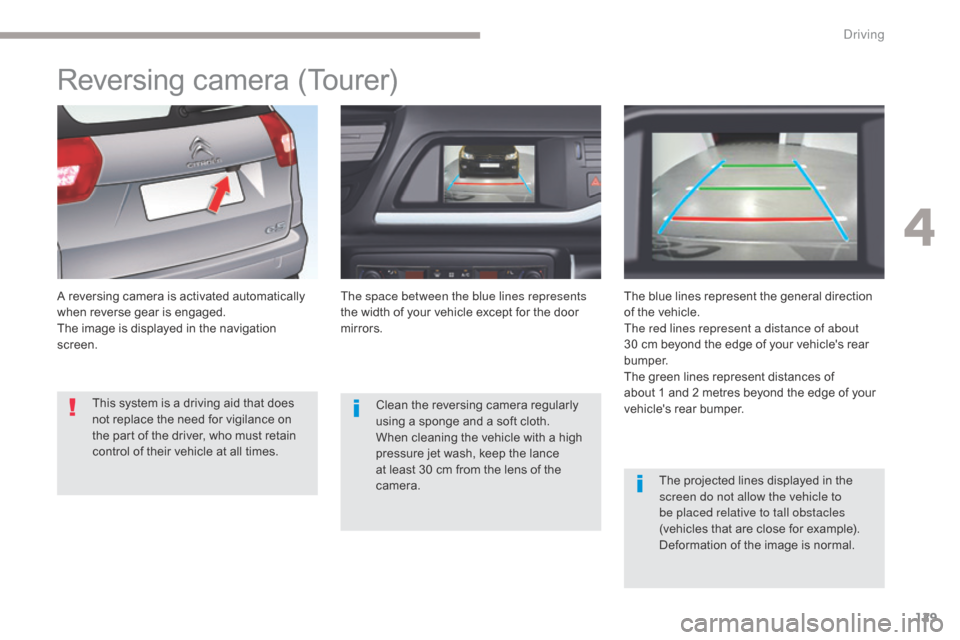
129
C5_en_Chap04_conduite_ed01-2016
Reversing camera (Tourer)
A reversing camera is activated automatically
when reverse gear is engaged.
The image is displayed in the navigation
screen.The space between the blue lines represents
the width of your vehicle except for the door
mirrors.
The blue lines represent the general direction
of the vehicle.
The red lines represent a distance of about
30 cm beyond the edge of your vehicle's rear
b u m p e r.
The green lines represent distances of
about
1 and 2 metres beyond the edge of your
vehicle's rear bumper.
The projected lines displayed in the
screen do not allow the vehicle to
be placed relative to tall obstacles
(vehicles that are close for example).
Deformation of the image is normal.
Clean the reversing camera regularly
using a sponge and a soft cloth.
When cleaning the vehicle with a high
pressure jet wash, keep the lance
at least 30 cm from the lens of the
camera.
This system is a driving aid that does
not replace the need for vigilance on
the part of the driver, who must retain
control of their vehicle at all times.
4
Driving
Page 132 of 348
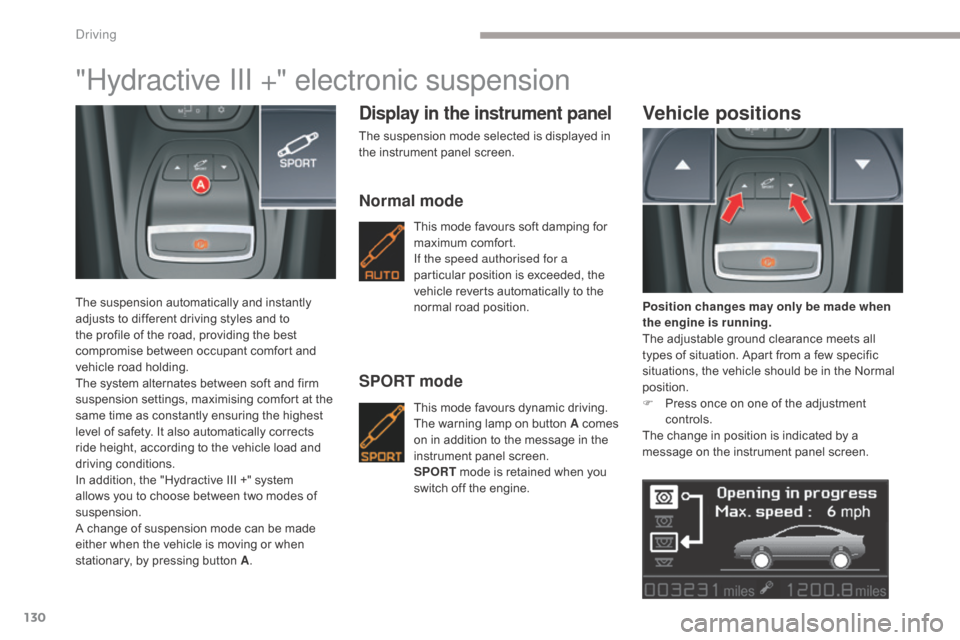
130
C5_en_Chap04_conduite_ed01-2016
"Hydractive III +" electronic suspension
The suspension automatically and instantly
adjusts to different driving styles and to
the profile of the road, providing the best
compromise between occupant comfort and
vehicle road holding.
The system alternates between soft and firm
suspension settings, maximising comfort at the
same time as constantly ensuring the highest
level of safety. It also automatically corrects
ride height, according to the vehicle load and
driving conditions.
In addition, the "Hydractive III +" system
allows you to choose between two modes of
suspension.
A change of suspension mode can be made
either when the vehicle is moving or when
stationary, by pressing button A.
Display in the instrument panel
The suspension mode selected is displayed in
the instrument panel screen.
Normal mode
This mode favours soft damping for
maximum comfort.
If the speed authorised for a
particular position is exceeded, the
vehicle reverts automatically to the
normal road position.
SPORT mode
This mode favours dynamic driving. T
he warning lamp on button A comes
on in addition to the message in the
instrument panel screen.
SPORT mode is retained when you
switch off the engine.
Vehicle positions
Position changes may only be made when
the engine is running.
The adjustable ground clearance meets all
types of situation. Apart from a few specific
situations, the vehicle should be in the Normal
position.
F
P
ress once on one of the adjustment
controls.
The change in position is indicated by a
message on the instrument panel screen.
Driving
Page 133 of 348
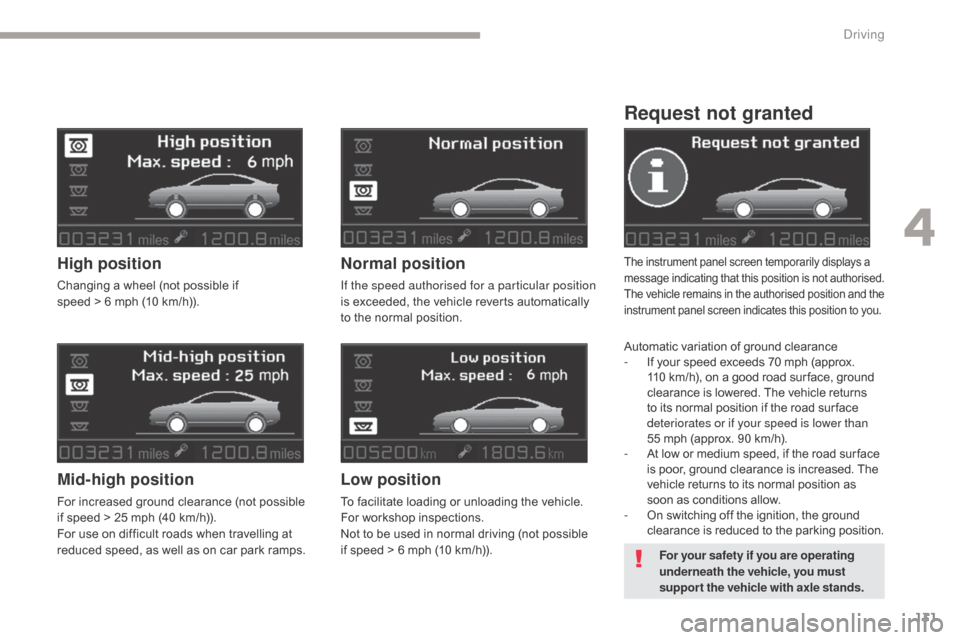
131
C5_en_Chap04_conduite_ed01-2016
Request not granted
The instrument panel screen temporarily displays a
message indicating that this position is not authorised.
The vehicle remains in the authorised position and the
instrument panel screen indicates this position to you.
Automatic variation of ground clearance
- If your speed exceeds 70 mph (approx.
110 km/h), on a good road sur face, ground
clearance is lowered. The vehicle returns
to its normal position if the road sur face
deteriorates or if your speed is lower than
55 mph (approx. 90 km/h).
-
A
t low or medium speed, if the road sur face
is poor, ground clearance is increased. The
vehicle returns to its normal position as
soon as conditions allow.
-
O
n switching off the ignition, the ground
clearance is reduced to the parking position.
Normal position
If the speed authorised for a particular position
is exceeded, the vehicle reverts automatically
to the normal position.
Low position
To facilitate loading or unloading the vehicle.
For workshop inspections.
Not to be used in normal driving (not possible
if speed > 6 mph (10
km/h)).
High position
Changing a wheel (not possible if
speed > 6 mph (10 km/h)).
Mid-high position
For increased ground clearance (not possible
if speed > 25 mph (40 km/h)).
For use on difficult roads when travelling at
reduced speed, as well as on car park ramps.
For your safety if you are operating
underneath the vehicle, you must
suppor t the vehicle with axle stands.
4
Driving
Page 134 of 348

132
C5_en_Chap05_eclairage-et-visibilite_ed01-2016
Exterior lighting controls
Main lighting
The various front and rear lamps of the
vehicle are designed to adapt the driver's
visibility progressively in relation to the climatic
conditions:
-
s
idelamps, to be seen,
-
d
ipped beam headlamps to see without
dazzling other drivers,
-
m
ain beam headlamps to see clearly when
the road is clear.
Additional lighting
Other lamps are fitted to meet the requirements
of particular driving conditions:
-
r
ear foglamps, to be seen from a distance,
-
f
ront foglamps for even better for ward
vision,
-
d
irectional headlamps for improved
visibility when cornering,
-
d
aytime running lamps to be seen during
the day.
Settings
You can configure some functions:
- d aytime running lamps,
-
a
utomatic illumination of headlamps,
-
d
irectional lighting,
-
g
uide-me-home lighting.
In some weather conditions (e.g. low
temperature or humidity), the presence
of misting on the internal sur face of the
glass of the headlamps and rear lamps
is normal; it disappears after the lamps
have been on for a few minutes.
Control stalk for the selection and control of the various front and rear lamps providing the vehicle's lighting.
Lighting and visibility
Page 135 of 348

133
C5_en_Chap05_eclairage-et-visibilite_ed01-2016
Manual controls
Lighting off (ignition off) /
Daytime running lamps (engine running).
Automatic illumination of headlamps.
Sidelamps.Dipped headlamps or main
beam headlamps.
B.
S
talk for switching headlamps: pull
the stalk towards you to switch the
lighting between dipped and main beam
headlamps.
In the lamps off and sidelamps modes, the
driver can switch on the main beam headlamps
temporarily ("headlamp flash") by maintaining a
pull on the stalk.
Displays
The lighting is controlled directly by the driver
by means of the ring A and the stalk B .A.
M
ain lighting mode selection ring: turn it
to position the symbol required facing the
mark.
C. Foglamps selection ring.
The foglamps operate with the sidelamps and
the dipped and main beam headlamps. Illumination of the corresponding indicator
lamp in the instrument panel confirms that the
lighting selected is on.
5
Lighting and visibility
Page 136 of 348
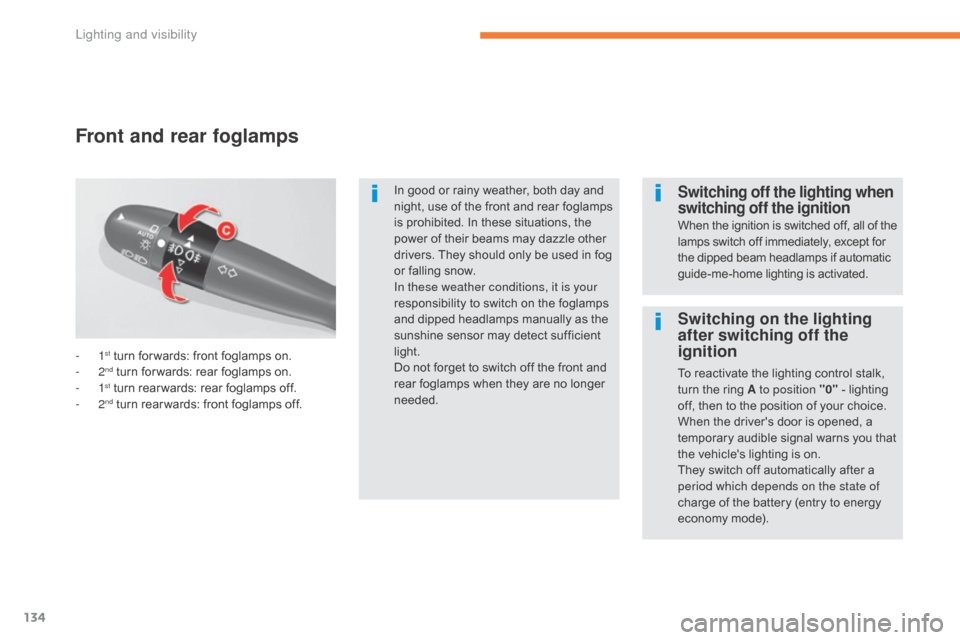
134
C5_en_Chap05_eclairage-et-visibilite_ed01-2016
- 1st turn for wards: front foglamps on.
-
2nd turn for wards: rear foglamps on.
-
1st turn rear wards: rear foglamps off.
-
2nd turn rear wards: front foglamps off.
Front and rear foglamps
In good or rainy weather, both day and
night, use of the front and rear foglamps
is prohibited. In these situations, the
power of their beams may dazzle other
drivers. They should only be used in fog
or falling snow.
In these weather conditions, it is your
responsibility to switch on the foglamps
and dipped headlamps manually as the
sunshine sensor may detect sufficient
light.
Do not forget to switch off the front and
rear foglamps when they are no longer
needed.Switching off the lighting when
switching off the ignition
When the ignition is switched off, all of the
lamps switch off immediately, except for
the dipped beam headlamps if automatic
guide-me-home lighting is activated.
Switching on the lighting
after switching off the
ignition
To reactivate the lighting control stalk,
turn the ring A to position "0" - lighting
off, then to the position of your choice.
When the driver's door is opened, a
temporary audible signal warns you that
the vehicle's lighting is on.
They switch off automatically after a
period which depends on the state of
charge of the battery (entry to energy
economy mode).
Lighting and visibility
Page 137 of 348

135
C5_en_Chap05_eclairage-et-visibilite_ed01-2016
Daytime running lampsManual guide-me-home
lighting
Switching on
F With the ignition off, "flash" the headlamps
using the lighting stalk.
F
A f
urther "headlamp flash" switches the
function off.
Switching off
The manual guide-me-home lighting switches
off automatically after a set time.
These special lamps, located at the front, make
the vehicle more visible by day.
The temporary illumination of the dipped beam
headlamps after the vehicle's ignition has been
switched off makes the driver's exit easier
when the light is poor.
They come on automatically and stay on, when
the engine is running and when the lighting
control stalk is at position 0 or AUTO
.
5
Lighting and visibility
Page 138 of 348
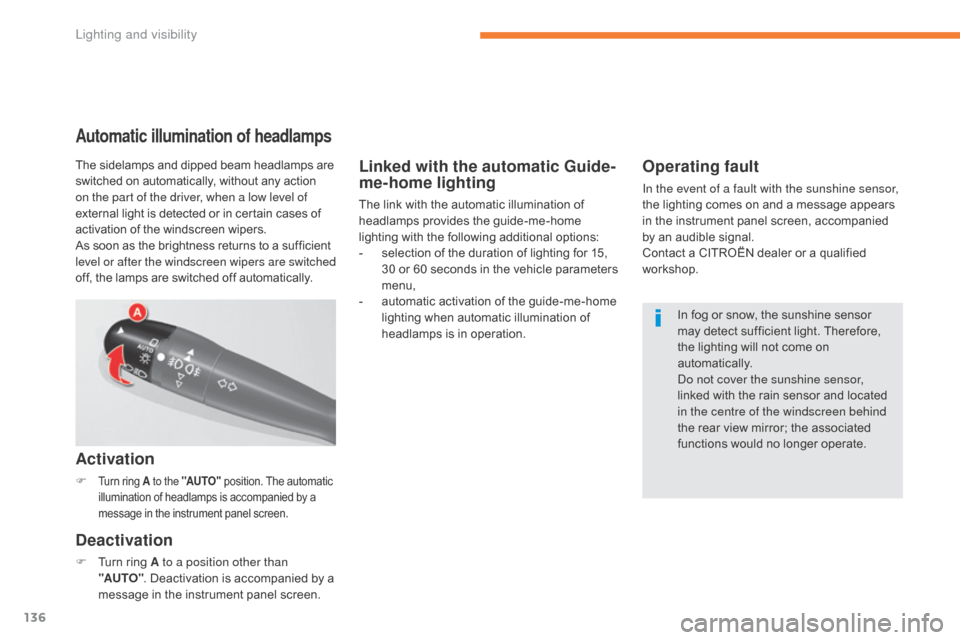
136
C5_en_Chap05_eclairage-et-visibilite_ed01-2016
Linked with the automatic Guide-
me-home lighting
The link with the automatic illumination of
headlamps provides the guide-me-home
lighting with the following additional options:
-
s
election of the duration of lighting for 15,
30 or 60 seconds in the vehicle parameters
menu,
-
a
utomatic activation of the guide-me-home
lighting when automatic illumination of
headlamps is in operation.
Operating fault
In the event of a fault with the sunshine sensor,
the lighting comes on and a message appears
in the instrument panel screen, accompanied
by an audible signal.
Contact a CITROËN dealer or a qualified
workshop.
Automatic illumination of headlamps
Activation
F Turn ring A to the "AUTO" position. The automatic
illumination of headlamps is accompanied by a
message in the instrument panel screen.
Deactivation
F Turn ring A to a position other than "AUTO" . Deactivation is accompanied by a
message in the instrument panel screen.
The sidelamps and dipped beam headlamps are
switched on automatically, without any action
on the part of the driver, when a low level of
external light is detected or in certain cases of
activation of the windscreen wipers.
As soon as the brightness returns to a sufficient
level or after the windscreen wipers are switched
off, the lamps are switched off automatically.
In fog or snow, the sunshine sensor
may detect sufficient light. Therefore,
the lighting will not come on
automatically.
Do not cover the sunshine sensor,
linked with the rain sensor and located
in the centre of the windscreen behind
the rear view mirror; the associated
functions would no longer operate.
Lighting and visibility
Page 139 of 348
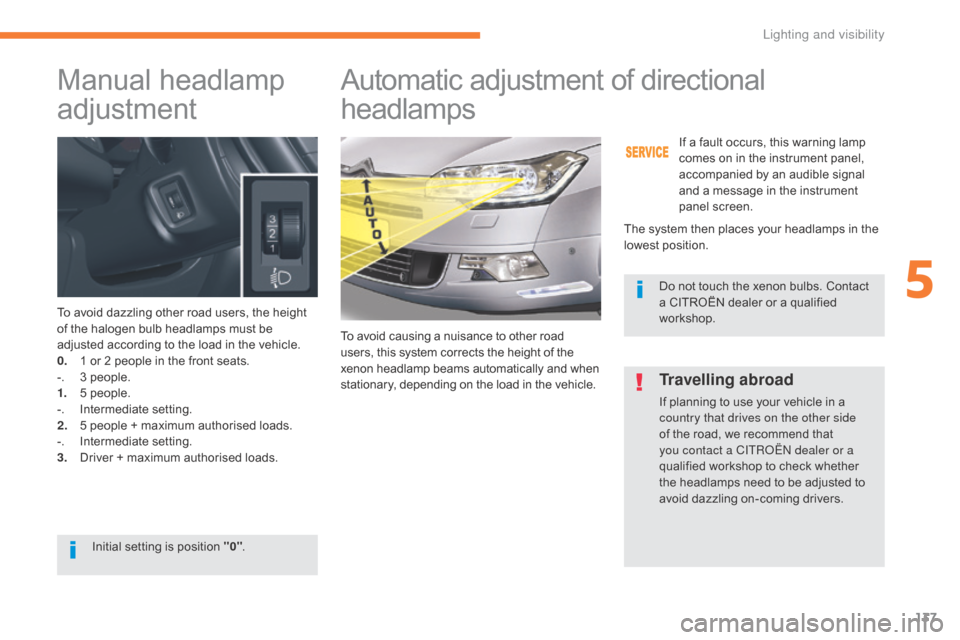
137
C5_en_Chap05_eclairage-et-visibilite_ed01-2016
Manual headlamp
adjustment
To avoid dazzling other road users, the height
of the halogen bulb headlamps must be
adjusted according to the load in the vehicle.
0.
1 o
r 2 people in the front seats.
-.
3 p
eople.
1.
5 p
eople.
-.
I
ntermediate setting.
2.
5 p
eople + maximum authorised loads.
-.
I
ntermediate setting.
3.
D
river + maximum authorised loads.
Automatic adjustment of directional
headlamps
The system then places your headlamps in the
lowest position. If a fault occurs, this warning lamp
comes on in the instrument panel,
accompanied by an audible signal
and a message in the instrument
panel screen.
Initial setting is position "0" .To avoid causing a nuisance to other road
users, this system corrects the height of the
xenon headlamp beams automatically and when
stationary, depending on the load in the
vehicle. Do not touch the xenon bulbs. Contact
a CITROËN dealer or a qualified
workshop.
Travelling abroad
If planning to use your vehicle in a
country that drives on the other side
of the road, we recommend that
you contact a CITROËN dealer or a
qualified workshop to check whether
the headlamps need to be adjusted to
avoid dazzling on-coming drivers.
5
Lighting and visibility
Page 140 of 348

138
C5_en_Chap05_eclairage-et-visibilite_ed01-2016
Directional lighting
without cornering lightingwith cornering lighting
"Cornering lighting" function
Activation
This function is activated:
- w hen the direction indicator is activated,
-
f
rom a certain angle of rotation of the
steering wheel.
Deactivation
This function is deactivated:
- b elow a certain angle of rotation of the
steering wheel,
-
w
hen stationary or at very low speed,
-
w
hen reverse gear is engaged,
-
w
hen the directional headlamps are
switched off.
With dipped or main beams, this function
provides additional lighting for the inside of a
bend, when the vehicle speed is below 25 mph
(approx 40 km/h).
This lighting is most useful when travelling at
low and medium speed (urban driving, winding
road, junctions, parking manoeuvres...).
Lighting and visibility